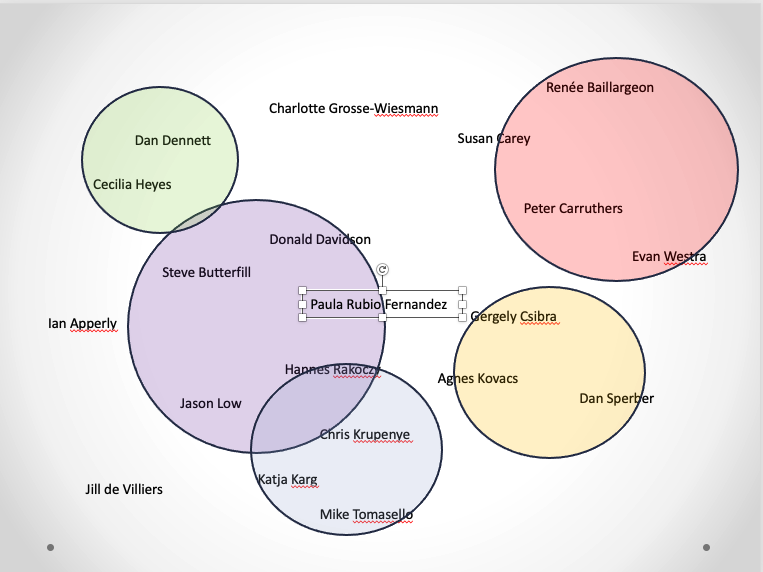
Theory of Mind in Humans and Non-Human Great Apes
Richard Moore, Berlin School of Mind and Brain blockseminar, July 2024
Day 1: Monday 29.07
09:30 – 11:00: Session 1: What is a ToM? Who has one?
● Premack, D. & Woodruff, G. (1978). Does the chimpanzee have a theory of mind? Behavioral and Brain Sciences, 1(04), 515-526.
● Responses by Jonathan Bennett, Daniel Dennett, Gil Harman.
11:15 – 12:45: Session 2: ToM in childhood
● Wimmer, H. & Perner, J. (1983) Beliefs about beliefs: Representation and constraining function of wrong beliefs in young children’s understanding of deception, Cognition, 13: 103–28.
● Liddle, B., & Nettle, D. (2006). Higher-order theory of mind and social competence in school-age children. Journal of Cultural and Evolutionary Psychology, 4(3-4), 231-244.
14:15 – 15:45: Session 3: ToM in infancy
● Onishi, K. H., & Baillargeon, R. (2005). Do 15-month-old infants understand false beliefs? Science, 308(5719), 255-258.
● Kovács, Á. M., Téglás, E., & Endress, A. D. (2010). The social sense: Susceptibility to others’ beliefs in human infants and adults. Science, 330(6012), 1830-1834.
● Carruthers, P. (2013) Mindreading in Infancy. Mind & Language, 28(2): 141-172.
16:00 to 17:30: Session 4: Mindreading in non-human great apes
- Krupenye, C., Kano, F., Hirata, S., Call, J. & Tomasello, M. (2016). Great apes anticipate that other individuals will act according to false beliefs. Science, 354(6308), 110-114.
- Heyes, C. (2017). Apes submentalise. Trends in Cognitive Sciences, 21(1), 1-2.
- Kano, F.*, Krupenye, C.*, Hirata, S., Call, J., and Tomasello, M. (2017). Submentalizing cannot explain belief-based action anticipation in apes. Trends in Cognitive Sciences. 21(9): 633-634. doi: http://dx.doi.org/10.1016/j.tics.2017.06.011.
Day 2: Wednesday 31.07
09:30 – 11:00: Session 5: Pragmatics and ToM 1
● Helming, K. A., Strickland, B., & Jacob, P. (2016). Solving the Puzzle about Early Belief‐Ascription. Mind & Language, 31(4), 438-469.
● Westra, E. (2016). Pragmatic development and the false belief task. Review of Philosophy and Psychology, 1-2.
11:15 – 12:45: Session 6: Pragmatics and ToM 2
● Rubio-Fernández, P. & Geurts, B. (2013). How to pass the false-belief task before your 4th birthday. Psychological Science, 24, 27-33.
● Rubio-Fernández, P. & Geurts, B. (2015). Don't mention the marble! The role of attentional processes in false-belief tasks. Review of Philosophy and Psychology.
14:15 – 15:45: Session 7: Language development and ToM
● De Villiers, J. & De Villiers, P. (2000). Linguistic determinism and the understanding of false belief. In Mitchell & Riggs (eds). Children's Reasoning and the Mind. Hove: Psychology Press, pp.191-228.
● Lohmann, H. & Tomasello, M. (2003). The role of language in the development of false belief understanding: a training study. Child Development, 74(4), 1130-1144.
● Low, J. (2010). Preschoolers’ implicit and explicit false-belief understanding: relations with complex syntactical mastery. Child Development, 81(2), 597-615.
14:15 – 15:45: Session 8: ToM and the Brain
● Grosse Wiesmann, C., Friederici, A. D., Singer, T., & Steinbeis, N. (2017). Implicit and explicit false belief development in preschool children. Developmental Science, 20(5), e12445.
● Grosse Wiesmann, C., Friederici, A. D., Singer, T., & Steinbeis, N. (2020). Two systems for thinking about others’ thoughts in the developing brain. Proceedings of the National Academy of Sciences, 117(12), 6928-6935.
Day 3: Friday 01.08
09:30 – 11:00: Session 9: Cross-cultural differences in human ToM
● Mayer, A. & Träuble, B. (2013). Synchrony in the onset of mental state understanding across cultures? A study among children in Samoa. International Journal of Behavioral Development, 37(1), 21-28.
● Pyers, J. E. & Senghas, A. (2009). Language promotes false-belief understanding evidence from learners of a new sign language. Psychological Science, 20(7), 805-812.
11:15 – 12:45: Session 10: Two-systems approaches to ToM development
● Apperly, I. & Butterfill, S. (2009) Do humans have two systems to track beliefs and belief-like states? Psychological Review, 116: 953–70.
● Heyes, C. M., & Frith, C. D. (2014). The cultural evolution of mind reading. Science, 344(6190), 1243091.
14:15 – 15:45: Session 11: Level-2 perspective-taking
● Moll, H., & Meltzoff, A. N. (2011). How does it look? Level 2 perspective‐taking at 36 months of age. Child development, 82(2), 661-673.
● Karg, K., Schmelz, M., Call, J., & Tomasello, M. (2016). Differing views: Can chimpanzees do Level 2 perspective-taking?. Animal Cognition, 19, 555-564.
16:00 to 17:30: Session 12: Closing discussion
Additional readings
● Apperly, I. (2011). Mindreaders.
● Martin, A. & Santos, L.R. (2016). What cognitive mechanisms support primate theory of mind? Trends in Cognitive Sciences.
● Martin, A. & Santos, L.R. (2014). The origins of belief representation: Monkeys fail to automatically represent others’ beliefs. Cognition, 130 (3): 300-308.
● Moore, R. (2021). The cultural evolution of mind-modelling. Synthese, 199(1), 1751-1776.
● Scott & Baillargeon. (2017). Early false-belief understanding. TiCS.
● Kaminski, J., Call, J. & Tomasello, M. (2008). Chimpanzees know what others know, but not what they believe. Cognition. 109(2):224-34.
- Kursverantwortliche/r: Evaluationsbeauftragte Anne Aerts
- Kursverantwortliche/r: Dirk Mende
- Kursverantwortliche/r: Richard Moore